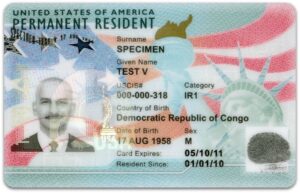
United States immigration laws provide a variety of ways to apply for a green card (permanent resident status). The different paths come through family relationships, employment, refugee/asylum status, diversity lottery, and several special immigrant classes.
However, the vast majority of immigrants apply for a green card through a family relationship. For example, almost 69 percent of the more than one million people who obtained a green card in 2019 were in a family-based category according to USCIS statistics. The application process for family-based permanent residence is the focus of this article.
Determine If You Have Eligibility Through a Family Member
Are you related to a U.S. citizen or lawful permanent resident? To apply for a green card through a family relationship, you must have one of only a handful of eligible relationships with a U.S. citizen or lawful permanent resident. Family-based immigration falls into two categories: immediate relatives and family-preference.
Immediate Relative Category
Immigration law categorizes the spouse, unmarried children (under age 21) and parents of U.S. citizens as immediate relatives. That’s it. The immediate relative category is an exclusive group. That’s because an immigrant visa is always available. There is no “wait” for a visa if you are an immediate relative. The paperwork takes some time, but immediate relatives aren’t subject to the long waits associated with other categories. Again, immediate relatives only include:
- Spouse of a U.S. citizen
- Unmarried child under the age of 21 of a U.S. citizen
- Parent of a U.S. citizen who is at least 21 years old
Family Preference Category
Most other eligible family members fall into the family preference category. Family preference categories often have a longer wait associated with them. That’s because there is a numerical limit of immigrant visas available to family preference immigrants each year.
- Unmarried, adult sons and daughters (age 21 or over) of U.S. citizens
- Spouses and unmarried children (under age 21) of permanent residents
- Unmarried adult sons and daughters of permanent residents
- Married sons and daughters (any age) of U.S. citizens
- Brothers and sisters of adult U.S. citizens
Other Relationships
Fiancé(e)s of U.S. citizens also have a path to a green card, but they don’t fit into one of the categories above. Learn more about the K-1 visa path to a green card for fiancés.
Additionally, the widow(er) of a U.S. citizen may be eligible for a green card if he or she was married at the time the U.S. citizen spouse died. Certain family member victims of battery or extreme cruelty by a U.S. citizen may also be eligible to apply for a green card through a VAWA self-petition. These cases can get complicated. Therefore, widow(er) and VAWA self-petitioners should generally work with an immigration attorney to apply.
On the other hand, grandparents, grandchildren, nephews, nieces, uncles, aunts, cousins and in-laws cannot be directly petitioned.
Obtain Sponsorship from the Family Member
Before you can apply for a green card, an “immigrant visa” must be available. An immigrant visa is a permanent visa that allows a foreign national to permanently live and work in the United States (provided he/she stays within the rules). It’s also known as permanent resident status. USCIS provides every U.S. permanent resident with a permanent resident card, best known as a green card.

Your family member must begin by requesting an immigrant visa be made available to you. Specifically, the process starts by filing an immigrant petition. Regardless of your family-based category — immediate relative or family preference – the process begins with the U.S. citizen or permanent resident filing Form I-130, Petition for Alien Relative, with the U.S. government. Use Form I-130 to establish the existence of a qualifying relationship and to make a request for a visa to be set aside.
As mentioned previously, immediate relatives will always have an available immigrant visa. In contrast, family preference relatives will have a wait that can last a few months to several years. It depends on how many people are also waiting in the same category as well as other factors.
RECOMMENDED: How the Visa Bulletin Works
Other classes of admission have different petitions. For example, there is an alien worker petition (Form I-140), special immigrant petition (I-360) and a refugee/asylee relative petition (I-730).
Apply for a Green Card
Once the visa petition (Form I-130) is approved and an immigrant visa is immediately available, the family member may submit the application for a green card. Generally, there are two ways this may happen. The family member may apply for a green card outside the United States, and certain persons may apply inside the United States.
Applying for a Green Card Outside the U.S.
Most people apply for a green card at a U.S. embassy or consulate outside the United States. This is formally known as consular processing. The intending immigrant submits the application and all required documentation to the National Visa Center and/or the embassy handling the visa. Then, an embassy official will also conduct a consular interview before granting the immigrant visa.
Applying for a Green Card Inside the U.S.

Certain individuals who are physically present in the United States through a lawful entry may be able to use the adjustment of status process to apply for a green card. When adjusting status, the intending immigrant must have an immigrant visa immediately available to them. Generally, this makes adjustment available only to immediate relatives (who always have a visa available). Certain family preference immigrants who have an approved I-130 and a visa is current may also adjust status. But this is less common.
An adjustment of status application typically includes a package of forms and supporting documents to include:
- I-485, Application to Register Permanent Residence or Adjust Status
- I-130, Petition for Alien Relative
- I-130A, Supplemental Information for Spouse Beneficiary (if relative is a spouse)
- I-864, Affidavit of Support
- I-693, Report of Medical Examination and Vaccination Record
- I-765, Application for Employment Authorization (optional)
- I-131, Application for Travel Document (optional)
If using CitizenPath to prepare your adjustment of status package, we’ll provide detailed filing instructions (based on your situation) that explain exactly which supporting documents to include with each form. If preparing on your own, please refer to the USCIS filing instructions on the USCIS website.
Preparing a Green Card Application Package
Filling out forms correctly and assembling a proper package of materials is critical. Based on Lockbox Rejection Data, USCIS rejects almost 10 percent of applications. Once applications are accepted processing, USCIS may also deny the case. In the most recent four quarters, USCIS has an average denial rate of over 18 percent for family-based I-485 applications according to DHS statistics.
Most intending immigrants can apply for a green card on their own, but benefit from some extra help. That’s where CitizenPath comes in. Our affordable service makes the application process easier with step-by-step guidance. The attorney-designed software provides instant alerts when there’s a problem. In addition to a neatly prepared application that’s ready to sign, our customers get detailed filing instructions based on their answers. The customized filing instructions provide directions for supporting documents, how to assemble the package and where to mail it. Watch a video explainer or get started for free.
Green Card Time Line
Several factors affect the green card time line. For starters, the eligibility category (immediate relative or family preference) has a significant affect on the wait. As explained, a green card is always available to immediate relatives. However, family preference categories can wait a few months up to 20 years in some cases.
For applicants that are able to adjust status within the United States, the I-485 time line can generally last from 8 to 14 months. However, it can take longer for certain cases.
RECOMMENDED: What Happens After Filing Form I-485
About CitizenPath
CitizenPath provides simple, affordable, step-by-step guidance through USCIS immigration applications. Individuals, attorneys and non-profits use the service on desktop or mobile device to prepare immigration forms accurately, avoiding costly delays. CitizenPath allows users to try the service for free and provides a 100% money-back guarantee that USCIS will approve the application or petition. We provide support for the Adjustment of Status Application (Form I-485), Petition for Alien Relative (Form I-130), and several other USCIS immigration forms.
Want more immigration tips and how-to information for your family?
Sign up for CitizenPath’s FREE immigration newsletter and
SAVE 10%
on our immigration services



